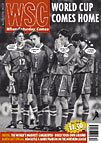 Ewan Davidson recounts several tales of horrible conditions in the Wild West
Ewan Davidson recounts several tales of horrible conditions in the Wild West
Many non-natives believe all of Scotland shares the same climate. In fact, the West coast gets almost twice as much rainfall as the East. And for reasons I’ve never understood, more than half the population lives in the West too (something to do with tobacco I’ve been told, but it doesn’t grow there, although rice might).
Much of this rainfall seems mysteriously drawn to the inadequately-protected terraces of lower-league football grounds. And because of the equally mysterious Scottish mini-league structure, a travelling Brechin City supporter such as myself is drawn there, too. Memory compresses umpteen visits to Boghead, Cliftonhill, Broomfield, Cappielow and their ilk into one sodden recollection.
Cursory checks before departure suggest bright promise – so leaving behind galoshes and sou’wester, you set off for the train. But on the journey across the desolate moors of West Lothian, cloud thickens and becomes insistent. When the train stops mysteriously at Croy, big gobs are crashing off the windows. In Glasgow, changing trains, you pass other supporters heading for Parkhead, Ibrox or anywhere with cover. Your socks are already sticking to the soles of your shoes.
After the walk from the station to the ground, it doesn’t really matter whether you’re going to brave the locals in the shed or perch alone on the terraces. The only way to keep warm, and hopefully dry, is to keep moving. Anywhere with seats is a nightmare. Kilbowie Park, Clydebank’s 1960s state-of-the-art stadium, had benches but no roof and a group of Strathclyde’s finest duly policed the away end making sure you stayed in them. By the time of the journey back, socks and trousers would have absorbed so much water that you’d travel in your own personalized cloud, and leave the train moving like John Wayne with a nasty case of piles.
Two sorts of games get played in this weather – the ‘bar of soap’ affair, and in conditions of sustained downpour, the ‘sticky toffee pudding’. Thrills and spills in the first, a right stramash in the second with the players being removed from the pitch at the end by a plumber wearing flippers and using a specialized set of Dynorods.
Douglas Park, Hamilton, was always the place for the ‘bar of soap’ game. When it rained in Hamilton, Brechin got gubbed. Always. The pitch, usually the texture of a well-grassed building site, took on the sheen of an ice rink. Even the crossfield hollows, testament to the area’s coalmining past, failed to trip up Hamilton’s specially-developed light forwards – Peter Duffield and Colin McDonald to name but two – who would skate rings around our landlubbers. With the Accies lutzing and salkoing to a three or four-goal half-time lead, and resuming in clean strips after the Wet Wet Wet records, the final score usually depended on how much ire the perpetually unsatisfied home support could communicate to their aquaplaning representatives.
In Brechin’s last season in Division One, our first game at Hamilton finished 9–0 – at the time a post-reconstruction league record. In the second, not only did we hold them to 5–1, but their Crawford Baptie departed early for two mistimed (as in the wrong day) tackles. As I paddled back to the station, I was able to reflect: “Ah well, we’re getting the hang of this now. I’ll certainly be back if we’re ever promoted and get another chance.”
Sadly, they closed Douglas Park first and the ghosts of our overbalancing defenders must haunt the strangely uneven floor just behind the cheese counter of whatever replaced it.
From WSC 121 March 1997. What was happening this month